/
STS-35
Launch Success
Liftoff Time (GMT)
06:49:01
Sunday December 2, 1990
Watch Replay
Official Livestream
Mission Details
STS-35
The primary payload of mission STS-35 was ASTRO-1, the fifth flight of the Spacelab system and the second with the Igloo and pallet train configuration. The primary objectives were round-the-clock observations of the celestial sphere in ultraviolet and X-ray spectral wavelengths with the ASTRO-1 observatory, consisting of four telescopes: Hopkins Ultraviolet Telescope (HUT); Wisconsin Ultraviolet Photo-Polarimeter Experiment (WUPPE); Ultraviolet Imaging Telescope (UIT), mounted on the Instrument Pointing System (IPS). The Instrument Pointing System consisted of a three-axis gimbal system mounted on a gimbal support structure connected to a Spacelab pallet at one end and the aft end of the payload at the other, a payload clamping system for support of the mounted experiment during launch and landing, and a control system based on the inertial reference of a three-axis gyro package and operated by a gimbal-mounted microcomputer. The Broad-Band X-Ray Telescope (BBXRT) and its Two-Axis Pointing System (TAPS) rounded out the instrument complement in the aft payload bay.
Low Earth Orbit
12,095 kilograms
Rocket


Agency
NASAPrice
$450.00 million
Rocket
Height: 56.1m
Payload to Orbit
LEO: 27,500 kg
GTO: 3,810 kg
Liftoff Thrust
30,250 Kilonewtons
Stages
2
Strap-ons
2
Launch Site
Stats
Space Shuttle
38th
Mission
6th
Mission of 1990
1990
111th
Orbital launch attempt
